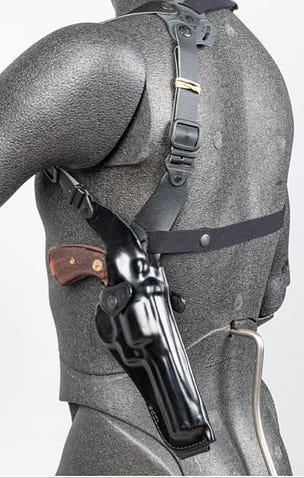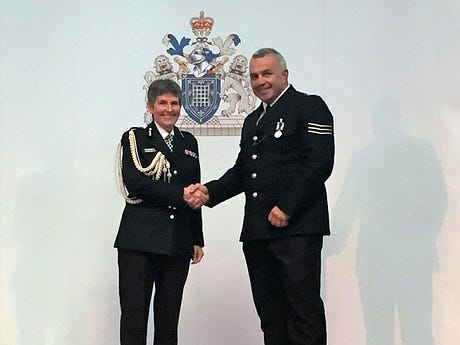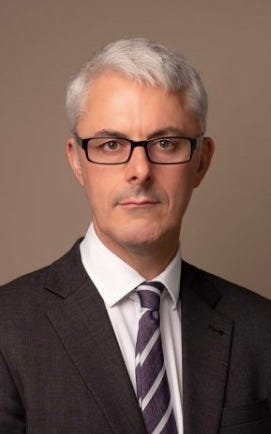The Case of the Croydon Killing
 |
Leaked documents reveal shocking police failures on the night Metropolitan police sergeant Matt Ratana was shot dead by an autistic man.
Louis De Zoysa was carrying a large antique gun in a shoulder holster when officers stopped and searched him in the early hours of Friday 25 September 2020.
The roadside search, which lasted five minutes, found seven home made bullets in a breast pocket but incredibly not the revolver underneath his coat.
In all, five officers attended the incident before De Zoysa was transported to Croydon custody centre where he shot dead Ratana inside a cell while handcuffed behind his back.
The Met documents and a report by the police watchdog reveal that:
the officer who searched De Zoysa was a probationer with a poor training record.
no officer asked De Zoysa if he had a gun.
his jacket was not removed during the search or when his handcuffs were changed from a front to a back position.
De Zoysa was not monitored properly in the van as he contorted his body to get the gun into his hands.
No officer held him by the arm or handcuffs when escorting De Zoysa into the police cell.
De Zoysa, who is double-joined, was shot in the neck during a struggle with the probationer, which has left him brain damaged and in a wheelchair.
In the chaotic aftermath, the probationer picked up the revolver from the cell floor and disappeared into a room in the custody centre on his own.
He has also ‘misplaced’ the police notebook in which he made several entries about the stop and search.
An investigation by The Upsetter into the police watchdog’s response to the shooting has found that:
The Independent Office of Police Conduct (IOPC) immediately decided that the officers involved in the incident would be treated as witnesses and not investigated for any disciplinary or criminal offences.
The IOPC wanted to exonerate the officers before all the evidence had been obtained.
Key forensic tests were not carried out.
The police failures were kept from the public for three years while trust in the Met and watchdog was collapsing.
The Met had significant influence over what was supposed to be an ‘independent’ IOPC investigation.
The wider conduct of senior IOPC managers who oversaw the Ratana investigation is presently being investigated by an external inquiry.
De Zoysa, 26, is now serving a whole life sentence for the murder of Ratana, 54, who was weeks from retiring from the Met when he was gunned down.
James Young, his brother in New Zealand, has already slammed the force for not detecting the antique Colt Army Special revolver with a 3.5in barrel.
He accused the Met of “covering up” what happened the night his brother was killed.
The New Zealand family are not represented at the inquest into Ratana’s death, which opened yesterday in Croydon, south London and will examine “missed opportunities”, senior coroner Sarah Ormond-Walshe has promised.
In July, a jury at Northampton Crown Court found De Zoysa guilty of murder, rejecting his defence of manslaughter by diminished responsibility due to an “autistic meltdown”.
The former coder for the local tax office had lost several pre-trial hearings arguing his injuries rendered him unfit to stand trial.
The coroner is sitting without a jury at the request of the Met. Just over 50% of Croydon’s population are from black, Asian or other ethnic minorities.
Su Bushby, Sgt Ratana's girlfriend of five years, supported the no jury application. She is represented at the inquest by the same lawyer who sued the Met over the murder of a police officer while on duty at Westminster Palace.
A source said Bushby will consider suing the Met after the inquest. Her legal team was not aware until this month that the Health & Safety Executive (HSE) had completed an unpublished report into the shooting.
The HSE has written to all chief constables about its recommendations on improving training, supervision and monitoring.
An application by De Zoysa to adjourn the inquest pending the outcome of his appeal was rejected by the coroner.
The death of cop is always an opportunity for the ‘police family’ to reinforce the idea of their exceptionalism in the public’s mind.
However, Ratana died as the Met was sliding into an unprecedented crisis of trust, integrity and performance.
The killing took place in between two other shocking stop and search cases during the covid lockdown.
In July 2020, officers stopped black athletes Bianca Williams and Ricardo dos Santos in West London causing uproar once again among Londoners and the wider Black Lives Matter movement.
The then Met Commissioner Dame Cressida Dick went on radio to give officers her full support and to deny racism played any part.
Then in March 2021, diplomatic protection officer Wayne Couzens kidnapped, raped and murdered Sarah Everard, setting off a wave of protest over police misogyny and the failure to investigate violence against women and girls.
The Met held back from the public that Couzens had used his warrant card and handcuffs to detain Everard as she walked home alone at night.
As public support haemorrhaged, Ratana’s death in September 2020 was something the Met could rinse for public sympathy.
Three years on, controlling the narrative over Ratana is a key battleground for new commissioner, Mark Rowley, and for the Met’s survival and self-regulation.
Like a domestic abuser beseeching his battered partner, Rowley wants the public to believe his apologies for racist, misogynist and corrupt policing are sincere, to forgive him and accept that this time it really is different, meaningful change will happen if he’s given one last chance.
Meanwhile, the commissioner continues to use Ratana’s death as a reminder to the public of the price his officers pay for keeping them safe, while keeping them in the dark about failings on that night and what it says about the state of the Met...
The following article regarding what appears to be further restrictions on public dissemination of critical material is reproduced in full.
M'learned friends' contempt for open justice was barely disguised during a recent pre-trial hearing of an autistic man accused of murdering a Metropolitan police officer inside a custody centre.
There has been a catastrophic failure of policing in this unusual case, which the Met and its so-called watchdog want, as long as possible, to keep from the media and the public, whose trust in both bodies has haemorrhaged.
The Courts can now be added to that list.
Officers had failed to spot Louis de Zoysa was carrying a gun when they arrested him in the early hours of 23 September 2020 for possession of ammunition, then drove the 23-year-old to Croydon custody centre handcuffed behind his back.
Custody sergeant Matt Ratana died from two gunshots. A third shot hit the roof and the fourth struck de Zoysa’s neck, causing life-changing injuries.
On the day of the shooting, then Met Commissioner, Cressida Dick, immediately claimed the fourth shot was a suicide attempt. “Early indications” were that de Zoysa had “shot himself” she said before going on to warn the media not to speculate!
As The Upsetter has already revealed, de Zoysa’s parents were also given the same suicide theory when detectives came through their front door within six hours of the shooting, which had occurred shortly after 2am.
Luckily, the incident - from de Zoysa’s arrest at 1.15am to the shooting incident inside the custody centre - was all captured by police body worn cameras and CCTV.
Some 120 minutes of footage was edited to around 10 minutes for a three-day hearing that started this month on Monday 14 November in front of Mr Justice Jeremy Baker sitting at Northampton Crown Court.
The High Court judge had already seen the edited highlights and said twice on the first day that he supported them being shown in court where screens had been set up for viewing.
A notable presence at Court Four was Sue Busby, the girlfriend of Ratana, who was being minded by the police and kept apart from de Zoysa's parents.
Also present were reporters from The Mirror, The Times, Press Association and the BBC with others watching and listening in by live video link from London.
The video facility had started as an emergency coronavirus measure for the media and public to ensure hard won Open Justice principles, which apply to all courts and tribunals exercising a judicial power of the state, were not abandoned during the pandemic.
The measure proved such a hit that it was given statutory footing in this year’s Police, Crime, Sentencing and Courts Act, which the government hailed as giving “greater access to, and transparency of, our justice system.”
News that the prosecution was going to show the highlights in court created a much needed buzz to the hearing and generated discussion among reporters about asking the prosecutor for a copy.
Under Open Justice principles and well-established legal precedents that have followed challenges to the instinctual resistance of the state, judiciary and law enforcement over the years, the media can have access to documents and other material, such as CCTV, in a trial.
The presumption is in favour of disclosure, but this is qualified by issues such as individual privacy and reporting restrictions can be applied, if necessary, to prevent the risk of prejudice to a jury.
In the case of R v de Zoysa, the jury had not been sworn in yet and some reporting restrictions were in place, which meant much of what unfolded during the three-day hearing cannot be written about here.
However, in our role as ‘watchdog and bloodhound’ it is accepted that reporters must be able to understand often complex cases as they progress through pre-trial hearings and be in a position to investigate claims being made by both sides.
The CCTV highlights therefore were an essential part of understanding how it was that the police watchdog, the Independent Office of Police Conduct (IOPC), had managed to complete an investigation within two months of the shooting and exonerate officers over the failure to properly search de Zoysa before he arrived at the custody suite.
The IOPC, which like the Met is haemorrhaging public trust, has blocked any meaningful transparency since the incident two years ago and also refuses to explain how the accused came to be shot.
All the watchdog has said is that officers acted with bravery in trying to “disarm” de Zoysa.
Bad Penny
On Tuesday 15 November, minutes before the second day of the hearing started, prosecutor Duncan Penny KC explained to The Upsetter what extracts he was going to show.
The highlights would start with the search, include a bit in the police van and stop after the first two shots that killed Ratana. Asked why he was not showing the third and fourth shots, Penny said in his dour Scottish lilt that those sixteen seconds were “irrelevant”.
In the small window before the hearing started, The Mirror agreed to support a challenge to the prosecutor’s ploy.
But at 10.30am, when Penny rose to address the judge, the prosecutor announced a remarkable U-turn.
He told Mr Justice Baker that he had intended to show the edited highlight in court but had now decided not to for two reasons.
Firstly, the highlights would be placed in the public domain at “the appropriate time” down the line.
Secondly, Penny asked the court to believe he had suddenly discovered there were unnamed foreign media organisations lurking on the live video link who "might" publish the highlights because they were not bound by the reporting restrictions and the Contempt of Court Act as their UK counterparts.
That these johnny foreigner media had not bothered to report the previous day’s hearing, where a lot of juicy details were revealed, was of no consequence.
The prosecutor’s u-turn looked like a tantrum to frustrate the media and protect the Met for a wee bit longer.
Consequently, The Upsetter and The Mirror prepared a formal application to Mr Justice Baker for access to the video highlights, which it was expected the judge would decide when the hearing re-convened after two days on Friday 18 November.
Legal counsel for Reach plc, the media group that owns over one hundred regional newspapers and nine national titles, including The Mirror, set out the public interest arguments for disclosure and the law in a lengthy submission sent to the judge, the prosecution and defence barrister Imran Khan KC on Thursday.
The application said:
“It appears the Crown seeks to restrict the media’s ability to cover this important case and frustrate the fourth estate’s function of holding the police to account to the public.”
It was accompanied by witness statements from The Mirror’s crime editor and The Upsetter.
Come Friday, however, the judge addressed all remaining issues but totally ignored the media application.
Mr Justice Baker had given no indication in advance that he was not going to hear our application or the reasons why.
Such contempt is sadly not an uncommon phenomena for reporters covering the courts.
The reduction in that coverage of court cases across the UK, as media organisations cut costs and local papers shut down, has created, some argue, a sense among m’learned friends that they can do as they like because no one is watching.
The Upsetter momentarily halted the judge’s exit from Court Four. Would he care to explain? He is, after all, a public servant on the taxpayers’ coin.
The baubles, bowing and scraping are nothing more than outmoded customs bestowed on judges by a profession in preservation of its own self regard.
Needless to say, the interjection did not result in any proper consideration of a carefully considered written application from Reach plc’s barrister.
The following week, The Upsetter emailed Mr Justice Baker directly asking for his comments for an article. A press officer with no knowledge of what had happened in court responded instead.
“I have contacted the Judge regarding this case and understand that the CCTV footage in question was not played in open court. With this being the case the judge does not have the power to release it. If you wished to obtain the footage this would need to be sought from the CPS/ appropriate police force. I hope this makes sense and my apologies if it was not fully explained previously.”
The Upsetter replied:
Thanks for your speedy reply. However, I don't think it deals with the points raised in the Mirror application supported by my witness statement and my separate request for access to additional material referred to over the course of the 3-day hearing last week.
Mr Justice Baker made it clear in response to Mr Penny KC prosecuting that he had seen the CCTV provided by the Crown and was willing to see more and said on two occasions that it should be shown in the court.
Separately, the content of the CCTV was discussed in detail during openings, evidence from witnesses and closing submissions with timings given by Mr Penny KC.
I therefore believe that applying the relevant media law, principles and guidelines the material was before the judge, heavily referred to during court proceedings and falls to be disclosed following an appropriate and reasoned application by accredited journalists/media organisations.
The simple fact is the judge did not deal with a properly made application for access to documents by the media and did not provide the explanation for not doing so or the legal reasons for rejecting it.
And the belated reason now given - that the CCTV compilation was not played in court - I believe would not have prevented media access - for the reasons above.
Furthermore, the reason given today certainly does not apply to the other material set out in my witness statement, which was never considered because the entire media application was ignored.
It would also be helpful to understand what Mr Justice Baker meant by referring to him not being the trial judge and how he believes that means he does not have to consider a media application for those and any future hearings.
To which the press officer responded:
Though the CCTV may have been mentioned in court it remains the case that it is not within the power of the Judge to release, you would need to apply to the CPS or relevant police force. It would then be for them to decide whether to release this to you. Witness statements are also the property of the prosecution/ defence counsel and would be for them to release.
This typical experience at the hands of m’learned friends brought to mind the sentencing remarks of a senior judge when describing the character of a barrister and her two guilty co-defendants as “one of arrogance by educated individuals who considered that respect for the law was for others.”
And whose words were they? Mr Justice Baker.
And so it goes.












